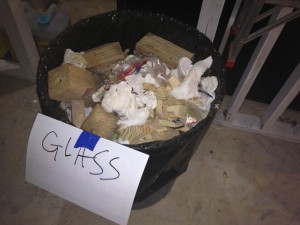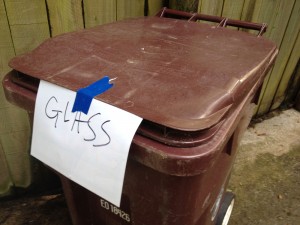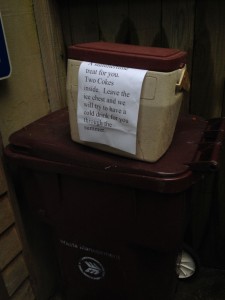No Southern-fried Southern boy wants to be called a Yankee, but we share the characteristics of shrewdness and thrift. Thus, each month we include a money-saving tip. It’s OK if you call me “cheap.
Steven Johnson once asked me, “With a trash can that big, how often do you empty it? Once a year?” I told him I really didn’t know, so the last time I put in a new bag I marked the date. Turns out, Steve was very close, as the can didn’t fill up for 13 months, and that includes emptying the other trash cans into it periodically.

July of this year the can was full, and it was time to empty it and let Steve know he’s a good guesser.
Sometimes we generate refuse in our woodworking shops that may hold the potential for harm to your sanitation workers. A few months ago I had some broken glass in the shop. I protected myself from it by placing a sign on the bag, ensuring I wouldn’t put my unprotected hand in harm’s way.

I don’t empty this can very often, so I didn’t want to take the chance that I’d forget the broken glass inside. A sign was a continual reminder.
If you have a Dumpster, the emptying of your trash is fully automated, and your garbage man never touches your refuse. At our office, the street side can is picked up by an arm remotely controlled by the driver, swinging the can into the air, then upside down, then back to the ground. A different company picks up our home refuse, though. While the emptying process is mechanized, the hopper, (as the man riding on the back of the truck is called) has the option to reach in the can to pull out plastic bags he judges to be light enough to speed the emptying process.

No one wants to allow harm to come to his fellow man. To protect the sanitation workers from harm if they reached into the can for the bag with glass inside, I warn them by transferring the sign from my indoor can to the outdoor one.
Sometimes the danger isn’t sharpness, but weight. If you have placed a lot of treated-lumber cutoffs into the bag, a large can will become quite heavy. We recycle so aggressively that our usual garbage-day load is one small bag, so our man is used to latching on to a light can. When we produce a lot of weight for the can, I always take a moment to make a sign to warn him so he doesn’t hurt himself.
Another appreciated thing you can do for your local sanitation engineers: Cool them off. During the summer I ice down a couple of Coca-Colas as a treat. And, a little check every Christmas. They have a hard job that no one wants. It’s not asking too much for us to be extra nice to them.

Recent temperatures approaching 100, with 90% humidity makes for a stratospheric heat index. Cool off the sanitation workers with a welcome cold treat.
—-
Jim Randolph is a veterinarian in Long Beach, Mississippi. His earlier careers as lawn mower, dairy farmer, automobile mechanic, microwave communications electronics instructor and journeyman carpenter all influence his approach to woodworking. His favorite projects are furniture built for his wife, Brenda, and for their children and grandchildren. His and Brenda’s home, nicknamed Sticks-In-The-Mud, is built on pilings (sticks) near the wetlands (mud) on a bayou off Jourdan River. His shop is in the lower level of their home. Questions and comments on woodworking may be written below in the comments section. Questions about pet care should be directed to his blog on pet care, www.MyPetsDoctor.com. We regret that, because of high volume, not all inquiries can be answered personally.


Jim, great tips… whenever I throw away a utility knife blade I wrap a small bit of duct tape around the sharp edge… partly so it doesn’t slice through the garbage bag and partly so it doesn’t inadvertently hurt someone.
Great idea, Steve! I don’t think I’ve ever discarded a utility knife blade, but if I ever do, I’ll be sure to do the same!
The last time I left a note it was taped to the outside of a sealed box containing a deceased critter: “DEAD SKUNK INSIDE !!!”